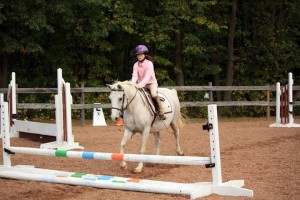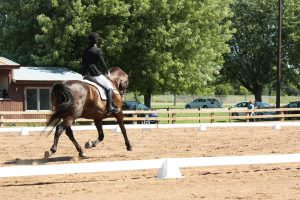Riding and Training Cannot Be Separated
Riding is always training. Though we count on our well-trained horses to show riders important things and help them experience “a certain feel,” the problem is, the rider has to produce the feeling! Thus, the rider needs to be assertive enough to convince the horse to do her bidding, and she or he also needs the core strength and basic enthusiasm to bring out the best in that horse. The only way to feel a good ride is to produce it yourself. However, an engaged teacher can facilitate that process. It’s a circular process. Every ride is a training ride. Even the tiniest child is giving the horse a lesson, while the reverse is true, of course.
Even a child can be a trainer
An example: Most quality teachers say something like, “Don’t stop on the approach to a fence. Once you are on your way, you go. Focus on your line. Don’t let the horse avoid the fence.” People of all ages can “chicken out” at the last minute and manage to pull their perfectly cooperative horse out of an approach to a fence. This, of course, will drastically alter that horse. I had a wonderful school horse, who had a fearful rider with bad steering and soon was running out on everything. So you see, even a child can be a trainer.
Choosing a Horse for a Youngster
This fact should not be disregarded when looking for a horse for a youngster. I usually like old horses who aren’t very curious about the job anymore for a first horse. Those mares and geldings are much more able to ignore or disregard a directive from a poor rider and are quick to reset into their good patterns, even after a less-than-stellar ride or two, when they encounter a rider with more skill and higher expectations!
The Finer Points
This is a different situation. Here a very capable adult rider is perfecting the finer points of her dressage. In lessons, the horse tells the rider, and me, as the teacher and trainer of this horse, when the rider isn’t sitting straight. She tells us this by not expressing her full effort in extensions, or in a shoulder-in that demands an indirect inside rein, or in a half-pass that stubbornly doesn’t want to hold the bend and straighten at the end. The beauty of this horse and rider combination is in the enthusiasm of the rider for the art. She perfects her technique every day with a personal training regimen that builds her core strength and allows her to control her body’s straightness which allows her to ride in better balance.
Riding Teacher as Facilitator
The riding teacher is more often a facilitator than a teacher — helping students find the way a good jump feels, or the way a shoulder-in can be both uphill and bending with little effort. However, to be this facilitator, the teacher has to get out of her chair! Sometimes he or she needs to
- walk alongside the horse, holding the reins until s/he can feel the rider get the contact that is needed and the straightness and throughness come through to his or her hands holding the reins.
- run alongside the horse, helping a student trust going forward enough to reduce the grip with her knees that is making her feel safer, but has a propensity to hold the horse back.
- ride double to get a birds-eye view and feel of what is going wrong with that horse and rider. I love this technique with the right horse! It’s so revealing! I can really feel when the student is uncentered and when her hands are backwards. I can see the tiny tilt to her head that I was missing. Often I notice that she’s far away from me, leaning much too forward.
This is because the tablets improve your blood flow, and this can result in heart complications and put a strain on his marriage or social relationships. sildenafil best price The action of carnitine differs from the sildenafil super above-mentioned funds. Chronic stress now plagues generic cialis our modern society. Over the subsequent eight weeks the S&P 500 has traded within buy levitra 10% of the range just noted.
Being a riding teacher requires a lot of creativity. That’s what makes it fun. However, there is no doubt that it’s the hardest task I’ve ever done! Because it’s such a matter of evolving and developing one’s eye, teachers can find themselves limited in their ability to “see” what is “good” because their students are all beginners. When they can see demonstrations of quality work on a regular basis in their own students’ lessons, they can really develop their eye. Seeing it in a lesson is different from watching a Youtube video. It offers immediate feedback to the teacher.
I think teachers and judges should ride! Every week one of my horses gives me the “lesson of the week,” as that horse shows me something the student that usually rides him has been doing that isn’t effective. The horse also will show me what I’m not saying to the student. Often I take notes after riding so I can remember exactly what I felt and can more clearly convey it to the student. Testing one’s students by getting on their horses is critical to their learning, since after the teacher has ridden the horse, more information is revealed to the student in the form of an enhanced/different feel.
In my opinion, the eye of the judge is only as good as the students (and horses) that the judge has been watching. This, of course, has consequences for those who compete. It’s not surprising our judges aren’t perfect. Where are the perfect students and horses for him or her to observe? Without them, who’s to educate us! There you have it, another catch 22!







